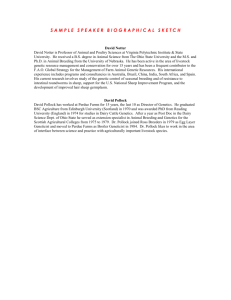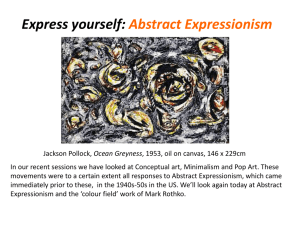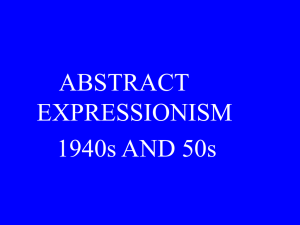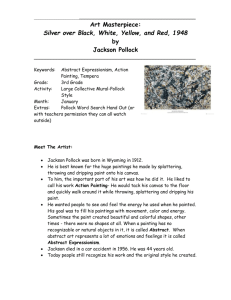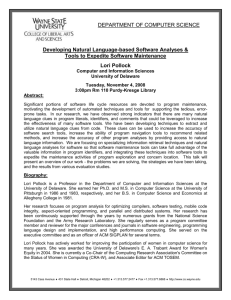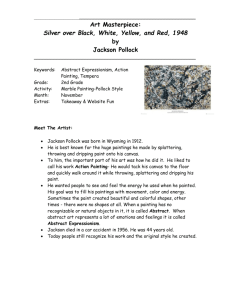AbstractExpressionistessayactivity.doc
advertisement
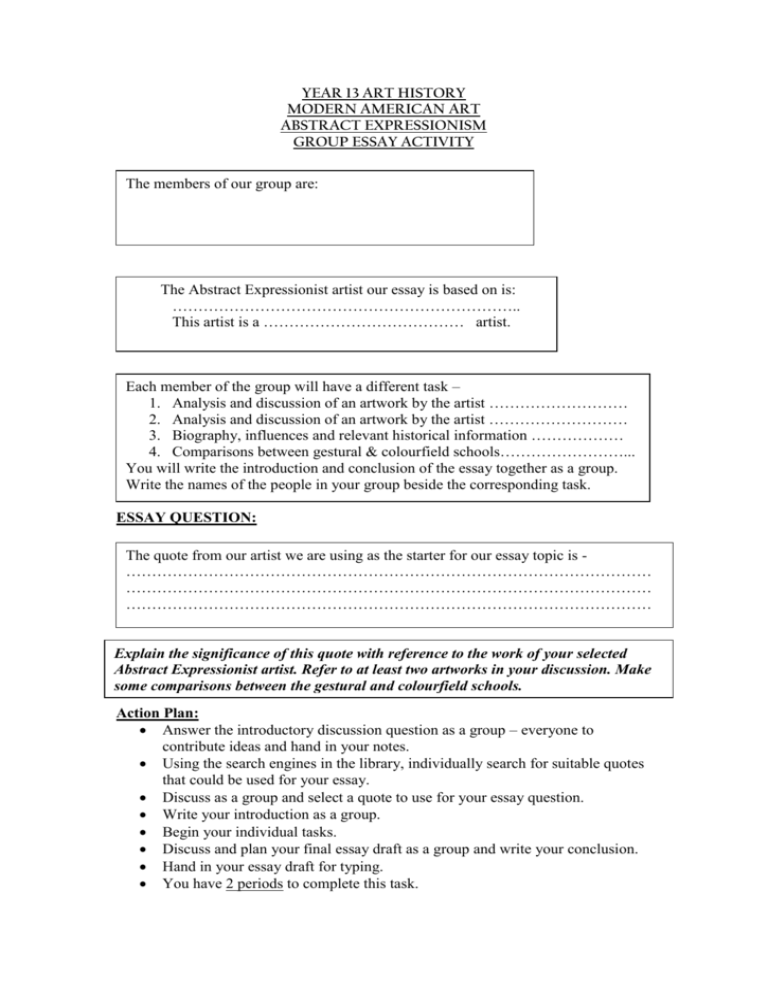
YEAR 13 ART HISTORY MODERN AMERICAN ART ABSTRACT EXPRESSIONISM GROUP ESSAY ACTIVITY The members of our group are: The Abstract Expressionist artist our essay is based on is: ………………………………………………………….. This artist is a ………………………………… artist. Each member of the group will have a different task – 1. Analysis and discussion of an artwork by the artist ……………………… 2. Analysis and discussion of an artwork by the artist ……………………… 3. Biography, influences and relevant historical information ……………… 4. Comparisons between gestural & colourfield schools……………………... You will write the introduction and conclusion of the essay together as a group. Write the names of the people in your group beside the corresponding task. ESSAY QUESTION: The quote from our artist we are using as the starter for our essay topic is ………………………………………………………………………………………… ………………………………………………………………………………………… ………………………………………………………………………………………… …………………............................................................................................................ Explain the significance of this quote with reference to the work of your selected Abstract Expressionist artist. Refer to at least two artworks in your discussion. Make some comparisons between the gestural and colourfield schools. Action Plan: Answer the introductory discussion question as a group – everyone to contribute ideas and hand in your notes. Using the search engines in the library, individually search for suitable quotes that could be used for your essay. Discuss as a group and select a quote to use for your essay question. Write your introduction as a group. Begin your individual tasks. Discuss and plan your final essay draft as a group and write your conclusion. Hand in your essay draft for typing. You have 2 periods to complete this task. SAMPLE : GROUP ESSAY: ABSTRACT EXPRESSIONISM – Elinor, Amy, Samantha ARTIST: Jackson Pollock QUOTE: The modern artist is working with space and time and expressing his feelings rather than illustrating… This quote was said by Jackson Pollock an abstract expressionist artist during the late 1930’s. The quote is very significant when one analyses Pollock’s artworks, for example Male and Female, 1942 and Eyes in the Heat, 1946. It is evident, that while working on his artworks, Pollock followed this quote in terms of the technique he used and the subject matter of each painting. Although Pollock was a gestural artist, his quote still applies to a number of colour field stylistic features, the other abstract expressionist school that developed during this time. Born in 1912, Jackson Pollock grew up in Arizona and California and studied in the Manual Arts High School in Los Angeles. During the `930’s, he studied under Thomas Hart Benton at the Art Student League where he was first influenced by Benton’s use of curvilinear lines and rural American subject matter. During the early 1940’s, Pollock developed his own unique ‘dripping’ technique, where he worked spontaneously with liquid paint on a canvas that was laid out on the studio floor. Although Pollock’s works were influenced by Indian sand painting, Mexican muralists and surrealist automatism, studies by Taylor, Micolich and Jonas have shown that Pollock’s work displays properties of mathematical fractals. Male and Female, painted in 1942, features the symbolism of man and woman. This painting is dominated by two totem-like figures, symbols of a male and female. Surrealist thought inspires the interpretation of these figures. The mysterious symbols of the male and female are strewn across the canvas with arithmetic notation. The triangles and diamonds represent the male and the circles and half circles represent the female. Male and Female is arranged in flat planes of cubism, with secondary planes linking them to one another and to their surrounding space. The composition is arranged in columns and vertical lines show influences of Asian art and Egyptian hieroglyphics. There are busy and empty spaces within the composition. Varied and different techniques are used including splatters, drawings and sketches. The paint is rough and thickly applied. The colours used are red, blue and yellow – primaries – plus black and white. These colours are contrasting and show the influence of the Navajo Indians. Eyes in the Heat, 1946-7, was a key work in Pollock’s career. During this time in Pollock’s life he began to work on the floor instead of an easel, so he could work from all four sides of the canvas. “On the floor I feel more at ease, I feel nearer, more a part of the painting, since this way I can walk around it, work from all four sides and be literally ‘in’ the painting…” This artwork was painted in winter, contrasting with the fiery, warm, earthy colours used. These colours swoop, rise and fall rhythmically over the entire canvas. The title of this work Eyes in the Heat reveals connotations of fire, hell and the sun. The eyes seen in this painting are the only recognisable forms within the lines and webs of paint and appear like ideographs, The eyes are almost entirely hidden, submerged in the layers of impasto paint, and appear to be watchful. These eyes appear here and there within the paint, mimicking the restless movement of the viewer’s eyes. Pollock’s technique in this work consists of throwing and dripping the paint on or squeezing it straight out of the tube onto the canvas. His method was quick and spontaneous. The tools Pollock used to paint were his fingers, sticks and paint trowels. Jackson Pollock, a gestural artist and Rothko a colour field artist used many different and contrasting ideas to make up their paintings. Pollock’s technique was unique and important to create the artwork to express his ideas. He would lay the canvas on the floor. He used hardened brushes, sticks and even basting syringes as paint applicators. Pollock’s technique of pouring and dripping painting is action painting, in which paint is spontaneously dribbled, splashed or smeared onto the canvas, rather than being carefully applied. This makes the work emphasise the physical act of painting itself. It was about the movement and the way paint was absorbed into the canvas. This difference between this and a colour field artists such as Rothko, is that Rothko’s work was done on an easel, the paint was applied very thinly with sponges and cloths leaving visible brushstrokes. Most of Rothko’s work was quite controlled, with the whole canvas painted and covered, unlike Pollock’s technique of wherever the paint landed. Rothko’s art aimed to focus on the colours and the moods that they created compared to Pollock, focussing on the movement and action of the paint on the canvas. Pollock’s subject matter was often abstract, with the occasional image made out, but he often left it up to the viewer to see what they could interpret from his works. This compares directly with Rothko’s works which have no subject matter and focus on the colours and the mood rather than a specific object or image. Pollock’s composition is complex, disordered and ‘all-over’. Because of his technique, there was no specific plan in where the paint had to go. There was also no central focus in the artwork and the work was done right out to the edges of the canvas, not stopping if it went over the edge. Rothko’s work was more planned out than Pollock’s, his works consisted mainly of large colour fields, divided by rectangles which were handled sensitively so that the rectangles appeared as though they were vibrating. The colours that Pollock used ranged from dark tones and light tones that he combined together in his art work. The contrast between the tones brought out the differences and added emphasis on them. The lighter, warmer tones used by Rothko all put emphasis on the emotion he was trying to make the viewer feel. Jackson Pollock was one of the most significant artists who explored gestural art. As his quote explains, he expressed his feelings rather than illustrating, using a technique that was unique for the time. Pollock’s artworks make it easy for one to see the similarities and contrasts between the two abstract expressionist schools – gestural and colour field. Overall, Pollock’s works are very original, introducing the art world to a whole new art concept.

